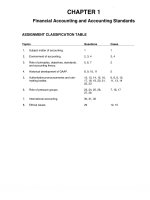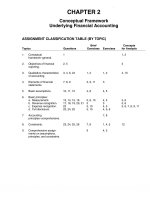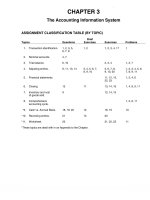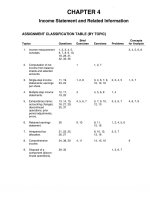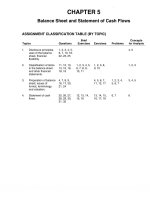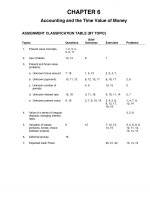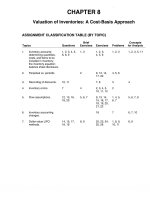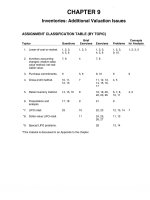Solution manual intermediate accounting 13e kieso ch13
Bạn đang xem bản rút gọn của tài liệu. Xem và tải ngay bản đầy đủ của tài liệu tại đây (441.55 KB, 74 trang )
To download more slides, ebook, solutions and test bank, visit
CHAPTER 13
Current Liabilities and Contingencies
ASSIGNMENT CLASSIFICATION TABLE (BY TOPIC)
Topics
Questions
Brief
Exercises
Exercises
Problems
Concepts
for Analysis
1, 16
1, 2
1
1, 2
1, 2
1.
Concept of liabilities;
definition and classification
of current liabilities.
1, 2, 3,
4, 6, 8
2.
Accounts and notes
payable; dividends payable.
7, 11
1, 2, 3
2, 16
3.
Short-term obligations
expected to be refinanced.
9, 10
4
3, 4
4.
Deposits and advance
payments.
12, 5
5
5.
Compensated absences.
13, 14, 15
8, 9
5, 6, 16
6.
Collections for third parties.
16
6, 7
7, 8, 9, 16
3, 4
7.
Contingent liabilities
(General).
17, 18, 19,
20, 22
10, 11
13, 16
10, 11, 13
5, 6, 7
8.
Guaranties and warranties.
21, 23
13, 14
10, 11, 16
5, 6, 7,
12, 14
7, 8
9.
Premiums and awards
offered to customers.
24, 25
15
12, 15, 16
8, 9, 12, 14
10.
Self-insurance, litigation,
claims, and assessments,
asset retirement obligations.
26, 27, 28
12
14
2, 10,
11, 13
6, 7
11.
Presentation and analysis.
29, 30, 31
17, 18, 19
9
3
Copyright © 2010 John Wiley & Sons, Inc.
3, 4
2
Kieso, Intermediate Accounting, 13/e, Solutions Manual
(For Instructor Use Only)
13-1
To download more slides, ebook, solutions and test bank, visit
ASSIGNMENT CLASSIFICATION TABLE (BY LEARNING OBJECTIVE)
Brief
Exercises
Learning Objectives
Exercises
Problems
1, 2
1.
Describe the nature, type, and valuation
of current liabilities.
1, 2, 3, 4,
5, 6
1, 2, 7
2.
Explain the classification issues of short-term
debt expected to be refinanced.
4
3, 4
3.
Identify types of employee-related liabilities.
7, 8, 9
5, 6, 8, 9
3, 4
4.
Identify the criteria used to account for and
disclose gain and loss contingencies.
10, 11, 12,
13, 14, 15
13
7, 10, 11, 13
5.
Explain the accounting for different types
of loss contingencies.
10, 11, 12,
13, 14, 15
10, 11, 12,
13, 14, 15
2, 5, 6, 7, 8,
9, 10, 11, 12,
13, 14
6.
Indicate how to present and analyze liabilities
and contingencies.
16, 17,
18, 19
9
13-2
Copyright © 2010 John Wiley & Sons, Inc.
Kieso, Intermediate Accounting, 13/e, Solutions Manual
(For Instructor Use Only)
To download more slides, ebook, solutions and test bank, visit
ASSIGNMENT CHARACTERISTICS TABLE
Description
Level of
Difficulty
Time
(minutes)
E13-1
E13-2
E13-3
E13-4
E13-5
E13-6
E13-7
E13-8
E13-9
E13-10
E13-11
E13-12
E13-13
E13-14
E13-15
E13-16
E13-17
E13-18
E13-19
Balance sheet classification of various liabilities.
Accounts and notes payable.
Refinancing of short-term debt.
Refinancing of short-term debt.
Compensated absences.
Compensated absences.
Adjusting entry for sales tax.
Payroll tax entries.
Payroll tax entries.
Warranties.
Warranties.
Premium entries.
Contingencies.
Asset retirement obligation.
Premiums.
Financial statement impact of liability transactions.
Ratio computations and discussion.
Ratio computations and analysis.
Ratio computations and effect of transactions.
Simple
Moderate
Simple
Simple
Moderate
Moderate
Simple
Simple
Simple
Simple
Moderate
Simple
Moderate
Moderate
Moderate
Moderate
Simple
Simple
Moderate
10–15
15–20
10–12
20–25
25–30
25–30
5–7
10–15
15–20
10–15
15–20
15–20
20–30
25–30
20–30
20–25
10–15
20–25
15–25
P13-1
P13-2
P13-3
P13-4
P13-5
P13-6
P13-7
P13-8
P13-9
P13-10
P13-11
P13-12
P13-13
P13-14
Current liability entries and adjustments.
Liability entries and adjustments.
Payroll tax entries.
Payroll tax entries.
Warranties, accrual, and cash basis.
Extended warranties.
Warranties, accrual, and cash basis.
Premium entries.
Premium entries and financial statement presentation.
Loss contingencies: entries and essay.
Loss contingencies: entries and essays.
Warranties and premiums.
Liability errors.
Warranty and coupon computation.
Simple
Simple
Moderate
Simple
Simple
Simple
Moderate
Moderate
Moderate
Simple
Moderate
Moderate
Moderate
Moderate
25–30
25–35
20–30
20–25
15–20
10–20
25–35
15–25
30–45
25–30
35–45
20–30
25–35
20–25
CA13-1
CA13-2
CA13-3
CA13-4
CA13-5
CA13-6
CA13-7
CA13-8
Nature of liabilities.
Current versus noncurrent classification.
Refinancing of short-term debt.
Refinancing of short-term debt.
Loss contingencies.
Loss contingency.
Warranties and loss contingencies.
Warranties.
Moderate
Moderate
Moderate
Moderate
Simple
Simple
Simple
Moderate
20–25
15–20
30–40
20–25
15–20
15–20
15–20
20–25
Item
Copyright © 2010 John Wiley & Sons, Inc.
Kieso, Intermediate Accounting, 13/e, Solutions Manual
(For Instructor Use Only)
13-3
To download more slides, ebook, solutions and test bank, visit
SOLUTIONS TO CODIFICATION EXERCISES
CE13-1
Master Glossary
(a)
An obligation associated with the retirement of a tangible long-lived asset.
(b)
Current liabilities is used principally to designate obligations whose liquidation is reasonably expected
to require the use of existing resources properly classifiable as current assets, or the creation of
other current liabilities.
(c)
The chance of the future event or events occurring is more than remote but less than likely.
(d)
A guarantee for which the underlying is related to the performance (regarding function, not price)
of nonfinancial assets that are owned by the guaranteed party. The obligation may be incurred in
connection with the sale of goods or services; if so, it may require further performance by the
seller after the sale has taken place.
CE13-2
According to FASB ASC 410-20-50-1 (Asset Retirement and Environmental Obligations):
An entity shall disclose all of the following information about its asset retirement obligations:
(a)
A general description of the asset retirement obligations and the associated long-lived assets
(b)
The fair value of assets that are legally restricted for purposes of settling asset retirement obligations
(c)
A reconciliation of the beginning and ending aggregate carrying amount of asset retirement obligations showing separately the changes attributable to the following components, whenever there
is a significant change in any of these components during the reporting period:
1.
2.
3.
4.
Liabilities incurred in the current period
Liabilities settled in the current period
Accretion expense
Revisions in estimated cash flows.
CE13-3
According to FASB ASC 450-10-55 (Contingencies —Implementation Guidance and Illustrations):
Depreciation
55-2
13-4
The fact that estimates are used to allocate the known cost of a depreciable asset over the period of use by an entity does not make depreciation a contingency; the eventual expiration of the
utility of the asset is not uncertain. Thus, depreciation of assets is not a contingency, nor are such
matters as recurring repairs, maintenance, and overhauls, which interrelate with depreciation.
This Topic is not intended to alter depreciation practices as described in Section 360-10-35.
Copyright © 2010 John Wiley & Sons, Inc.
Kieso, Intermediate Accounting, 13/e, Solutions Manual
(For Instructor Use Only)
To download more slides, ebook, solutions and test bank, visit
CE13-3 (Continued)
Estimates Used in Accruals
55-3
Amounts owed for services received, such as advertising and utilities, are not contingencies
even though the accrued amounts may have been estimated; there is nothing uncertain about
the fact that those obligations have been incurred.
Changes in Tax Law
55-4
The possibility of a change in the tax law in some future year is not an uncertainty.
CE13-4
According to FASB ASC 710-10-25-1 (Compensation Recognition—Compensated Absences), an
employer must accrue a liability for employees’ compensation for future absences if all of the following
conditions are met:
(a)
The employer’s obligation relating to employees’ rights to receive compensation for future
absences is attributable to employees’ services already rendered.
(b)
The obligation relates to rights that vest or accumulate. Vested rights are those for which the
employer has an obligation to make payment even if an employee terminates; thus, they are not
contingent on an employee’s future service. Accumulate means that earned but unused rights to
compensated absences may be carried forward to one or more periods subsequent to that in
which they are earned, even though there may be a limit to the amount that can be carried
forward.
(c)
Payment of the compensation is probable.
(d)
The amount can be reasonably estimated.
Copyright © 2010 John Wiley & Sons, Inc.
Kieso, Intermediate Accounting, 13/e, Solutions Manual
(For Instructor Use Only)
13-5
To download more slides, ebook, solutions and test bank, visit
ANSWERS TO QUESTIONS
1. Current liabilities are obligations whose liquidation is reasonably expected to require use of
existing resources properly classified as current assets or the creation of other current liabilities.
Long-term debt consists of all liabilities not properly classified as current liabilities.
2. You might explain to your friend that the accounting profession at one time prepared financial
statements somewhat in accordance with the broad or loose definition of a liability submitted by the
AICPA in 1953: “Something represented by a credit balance that is or would be properly carried
forward upon a closing of books of account according to the rules or principles of accounting,
provided such credit balance is not in effect a negative balance applicable to an asset. Thus the
word is used broadly to comprise not only items which constitute liabilities in the proper sense of
debts or obligations (including provision for those that are unascertained), but also credit balances
to be accounted for which do not involve the debtor and creditor relation.”
Since your friend may not have completely understood the above definition (if it may be called
that), you might indicate that more recent definitions of liabilities call for the disbursement of assets
or services in the future and that the present value of all of a person’s or company’s future
disbursements of assets constitutes the total liabilities of that person or company. But, accountants
quantify or measure only those liabilities or future disbursements which are reasonably determinable
at the present time. And, accountants have accepted the completed transaction as providing the
objectivity or basis necessary for financial recognition. Therefore, a liability may be viewed as an
obligation to convey assets or perform services at some time in the future and is based upon a
past or present transaction or event. A formal definition of liabilities presented in Concepts
Statement No. 6 is as follows: Probable future sacrifices of economic benefits arising from present
obligations of a particular entity to transfer assets or provide services to other entities in the future
as a result of past transactions or events.
3. As a lender of money, the banker is interested in the priority his/her claim has on the company’s
assets relative to other claims. Close examination of the liability section and the related footnotes
discloses amounts, maturity dates, collateral, subordinations, and restrictions of existing contractual
obligations, all of which are important to potential creditors. The assets and earning power are
likewise important to a banker considering a loan.
4. Current liabilities are obligations whose liquidation is reasonably expected to require the use of
existing resources properly classified as current assets, or the creation of other current liabilities.
Because current liabilities are by definition tied to current assets and current assets by definition
are tied to the operating cycle, liabilities are related to the operating cycle.
5. Unearned revenue is a liability that arises from current sales but for which some future services or
products are owed to customers in the future. At the time of a sale, customers pay not only for the
delivered product, but they also pay for future products or services (e.g., another plane trip, hotel
room, or software upgrade). In this case, the company recognizes revenue from the current product
and part of the sale proceeds is recorded as a liability (unearned revenue) for the value of future
products or services that are “owed” to customers. Market analysts indicate that an increase in the
unearned revenue liability, rather than raising a red flag, often provides a positive signal about
sales and profitability. When the sales are growing, its unearned revenue account should grow.
Thus, an increase in a liability may be good news about company performance. In contrast, when
unearned revenues decline, the company owes less future amounts but this also means that sales
of new products may have slowed.
6. Payables and receivables generally involve an interest element. Recognition of the interest element
(the cost of money as a factor of time and risk) results in valuing future payments at their current
value. The present value of a liability represents the debt exclusive of the interest factor.
13-6
Copyright © 2010 John Wiley & Sons, Inc.
Kieso, Intermediate Accounting, 13/e, Solutions Manual
(For Instructor Use Only)
To download more slides, ebook, solutions and test bank, visit
Questions Chapter 13 (Continued)
7. A discount on notes payable represents the difference between the present value and the face
value of the note, the face value being greater in amount than the discounted amount. It should be
treated as an offset (contra) to the face value of the note and amortized to interest expense over
the life of the note. The discount represents interest expense chargeable to future periods.
8. Liabilities that are due on demand (callable by the creditor) should be classified as a current
liability. Classification of the debt as current is required because it is a reasonable expectation that
existing working capital will be used to satisfy the debt. Liabilities often become callable by the
creditor when there is a violation of the debt agreement. Only if it can be shown that it is probable
that the violation will be cured (satisfied) within the grace period usually given in these agreements
can the debt be classified as noncurrent.
9. An enterprise should exclude a short-term obligation from current liabilities only if (1) it intends to
refinance the obligation on a long-term basis, and (2) it demonstrates an ability to consummate the
refinancing.
10. The ability to consummate the refinancing may be demonstrated (i) by actually refinancing the shortterm obligation through issuance of long-term obligation or equity securities after the date of the
balance sheet but before it is issued, or (ii) by entering into a financing agreement that clearly permits
the enterprise to refinance the debt on a long-term basis on terms that are readily determinable.
11. A cash dividend formally authorized by the board of directors would be recorded by a debit to
Retained Earnings and a credit to Dividends Payable. The Dividends Payable account should be
classified as a current liability.
An accumulated but undeclared dividend on cumulative preferred stock is not recorded in the
accounts as a liability until declared by the board, but such arrearages should be disclosed either
by a footnote to the balance sheet or parenthetically in the capital stock section.
A stock dividend distributable, formally authorized and declared by the board, does not appear as
a liability because a stock dividend does not require future outlays of assets or services and is
revocable by the board prior to issuance. Even so, an undistributed stock dividend is generally
reported in the stockholders’ equity section since it represents retained earnings in the process of
transfer to paid-in capital.
12. Unearned revenue arises when a company receives cash or other assets as payment from a
customer before conveying (or even producing) the goods or performing the services which it has
committed to the customer.
Unearned revenue is assumed to represent the obligation to the customer to refund the assets
received in the case of nonperformance or to perform according to the agreement and thus earn
the unrestricted right to the assets received. While there may be an element of unrealized profit
included among the liabilities when unearned revenues are classified as such, it is ignored on the
grounds that the amount of unrealized profit is uncertain and usually not material relative to the
total obligation.
Unearned revenues arise from the following activities:
(1) The sale by a transportation company of tickets or tokens that may be exchanged or used to
pay for future fares.
(2) The sale by a restaurant of meal tickets that may be exchanged or used to pay for future meals.
(3) The sale of gift certificates by a retail store.
(4) The sale of season tickets to sports or entertainment events.
(5) The sale of subscriptions to magazines.
Copyright © 2010 John Wiley & Sons, Inc.
Kieso, Intermediate Accounting, 13/e, Solutions Manual
(For Instructor Use Only)
13-7
To download more slides, ebook, solutions and test bank, visit
Questions Chapter 13 (Continued)
13. Compensated absences are employee absences such as vacation, illness, and holidays for which
it is expected that employees will be paid.
14. A liability should be accrued for the cost of compensated absences if all of the following conditions
are met:
(a) The employer’s obligation relating to employees’ rights to receive compensation for future
absences is attributable to employees’ services already rendered.
(b) The obligation relates to employees’ rights that vest or accumulate.
(c) Payment of the compensation is probable.
(d) The amount can be reasonably estimated.
If an employer meets conditions (a), (b), and (c), but does not accrue a liability because of failure
to meet condition (d), that fact should be disclosed.
15. An employer is required to accrue a liability for “sick pay” that employees are allowed to accumulate and use as compensated time off even if their absence is not due to illness. An employer is
permitted but not required to accrue to liability for sick pay that employees are allowed to claim
only as a result of actual illness.
16. Employers generally hold back from each employee’s wages amounts to cover income taxes
(withholding), the employee’s share of FICA taxes, and other items such as union dues or health
insurance. In addition, the employer must set aside amounts to cover the employer’s share of FICA
taxes and state and federal unemployment taxes. These latter amounts are recorded as payroll
expenses and will lower Battle’s income. In addition, the amount set aside (both the employee and
the employer share) will be reported as current liabilities until they are remitted to the appropriate
third party.
17. (a) A contingency is defined as an existing condition, situation, or set of circumstances involving
uncertainty as to possible gain (gain contingency) or loss (loss contingency) to an enterprise
that will ultimately be resolved when one or more future events occur or fail to occur.
(b) A contingent liability is a liability incurred as a result of a loss contingency.
18. A contingent liability should be recorded and a charge accrued to expense only if:
(a) information available prior to the issuance of the financial statements indicates that it is probable
that a liability has been incurred at the date of the financial statements, and
(b) the amount of the loss can be reasonably estimated.
19. A current liability is susceptible to precise measurement because the date of payment, the payee,
and the amount of cash needed to discharge the obligation are reasonably certain. There is nothing
uncertain about (1) the fact that the obligation has been incurred and (2) the amount of the obligation.
A contingent liability is an obligation that is dependent upon the occurrence or nonoccurrence of
one or more future events to confirm the amount payable, the payee, the date payable, or its
existence. It is a liability dependent upon a “loss contingency.”
Determinable current liabilities—accounts payable, notes payable, current maturities of longterm debt, dividends payable, returnable deposits, sales and use taxes, payroll taxes, and accrued
expenses.
Contingent liabilities—obligations related to product warranties and product defects, premiums
offered to customers, certain pending or threatened litigation, certain actual and possible claims and
assessments, and certain guarantees of indebtedness of others.
13-8
Copyright © 2010 John Wiley & Sons, Inc.
Kieso, Intermediate Accounting, 13/e, Solutions Manual
(For Instructor Use Only)
To download more slides, ebook, solutions and test bank, visit
Questions Chapter 13 (Continued)
20. The terms probable, reasonably possible, and remote are used in GAAP to denote the chances
of a future event occurring, the result of which is a gain or loss to the enterprise. If it is probable
that a loss has been incurred at the date of the financial statements, then the liability (if reasonably
estimable) should be recorded. If it is reasonably possible that a loss has been incurred at the
date of the financial statements, then the liability should be disclosed via a footnote. The footnote
should disclose (1) the nature of the contingency and (2) an estimate of the possible loss or range
of loss or a statement that an estimate cannot be made. If the incurrence of a loss is remote, then
no liability need be recorded or disclosed (except for guarantees of indebtedness of others, which
are disclosed even when the loss is remote).
21. Under the cash-basis method, warranty costs are charged to expense in the period in which the
seller or manufacturer performs in compliance with the warranty, no liability is recorded for future
costs arising from warranties, and the period of sale is not necessarily charged with the costs of
making good on outstanding warranties. Under the accrual method, a provision for warranty costs
is made at the time of sale or as the productive activity takes place; the accrual method may be
applied two different ways: expense warranty versus sales warranty method. But under either
method, the attempt is to match warranty expense to the related revenues.
22. Under U.S. GAAP, companies may not record provisions for future operating losses. Such provisions do not meet the definition of a liability, since the amount is not the result of a past transaction
(the losses have not yet occurred). Therefore the liability has not been incurred. Furthermore,
operating losses reflect general business risks for which a reasonable estimate of the loss could
not be determined. Note that use of provisions in this way is one of the examples of earnings
management discussed in Chapter 4. By reducing income in good years through the use of loss
contingencies, companies can smooth out their income from year-to-year.
23. The expense warranty approach and the sales-warranty approach are both variations of the accrual
method of accounting for warranty costs. The expense warranty approach charges the estimated
future warranty costs to operating expense in the year of sale or manufacture. The sales-warranty
approach defers a certain percentage of the original sales price until some future time when actual
costs are incurred or the warranty expires.
24. Southeast Airlines Inc.’s award plan is in the nature of a discounted ticket sale. Therefore, the fullfare ticket should be recorded as unearned transportation revenue (liability) when sold and
recognized as revenue when the transportation is provided. The half-fare ticket should be treated
accordingly; that is, record the discounted price as unearned transportation revenue (liability) when
it is sold and recognize it as revenue when the transportation is provided.
25. Although the accounting for this transaction has been studied, no authoritative guideline has been
developed to record this transaction. In the case of a free ticket award, AcSEC proposed that
a portion of the ticket fares contributing to the accumulation of the 50,000 miles (the free ticket
award level) be deferred as unearned transportation revenue and recognized as revenue when
free transportation is provided. The total amount deferred for the free ticket should be based
on the revenue value to the airline and the deferral should occur and accumulate as mileage is
accumulated.
26. An asset retirement obligation must be recognized when a company has an existing legal obligation
associated with the retirement of a long-lived asset and when the amount can be reasonably
estimated.
27. The absence of insurance does not mean that a liability has been incurred at the date of the financial
statements. Until the time that an event (loss contingency) occurs there can be no diminution in the
value of property or incurrence of a liability. If an event has occurred which exposes an enterprise to
risks of injury to others and/or damage to the property of others, then a contingency exists.
Expected future injury, damage, or loss resulting from lack of insurance need not be recorded or
disclosed if no contingency exists. And, a contingency exists only if an uninsurable event which causes
probable loss has occurred. Lack of insurance is not in itself a basis for recording a liability or loss.
Copyright © 2010 John Wiley & Sons, Inc.
Kieso, Intermediate Accounting, 13/e, Solutions Manual
(For Instructor Use Only)
13-9
To download more slides, ebook, solutions and test bank, visit
Questions Chapter 13 (Continued)
28. In determining whether or not to record a liability for pending litigation, the following factors must
be considered:
(a) The time period in which the underlying cause for action occurred.
(b) The probability of an unfavorable outcome.
(c) The ability to make a reasonable estimate of the amount of loss.
Before recording a liability for threatened litigation, the company must determine:
(a) The degree of probability that a suit may be filed, and
(b) The probability of an unfavorable outcome.
If both are probable, the loss reasonably estimable, and the cause for action dated on or before the
date of the financial statements, the liability must be accrued.
29. There are several defensible recommendations for listing current liabilities: (1) in order of maturity,
(2) according to amount, (3) in order of liquidation preference. The authors’ recent review of published financial statements disclosed that a significant majority of the published financial statements
examined listed “notes payable” first, regardless of relative amount, followed most often by “accounts
payable,” and ending the current liability section with “current portion of long-term debt.”
30. The acid-test ratio and the current ratio are both measures of the short-term debt-paying ability of
the company. The acid-test ratio excludes inventories and prepaid expenses on the basis that these
assets are difficult to liquidate in an emergency. The current ratio and the acid-test ratio are similar
in that both numerators include cash, short-term investments, and net receivables, and both
denominators include current liabilities.
31. (a) A liability for goods purchased on credit should be recorded when title passes to the purchaser.
If the terms of purchase are f.o.b. destination, title passes when the goods purchased arrive; if
f.o.b. shipping point, title passes when shipment is made by the vendor.
(b) Officers’ salaries should be recorded when they become due at the end of a pay period.
Accrual of unpaid amounts should be recorded in preparing financial statements dated other
than at the end of a pay period.
(c) A special bonus to employees should be recorded when approved by the board of directors or
person having authority to approve, if the bonus is for a period of time and that period has
ended at the date of approval. If the period for which the bonus is applicable has not ended
but only a part of it has expired, it would be appropriate to accrue a pro rata portion of the
bonus at the time of approval and make additional accruals of pro rata amounts at the end of
each pay period.
(d) Dividends should be recorded when they have been declared by the board of directors.
(e) Usually it is neither necessary nor proper for the buyer to make any entries to reflect commitments for purchases of goods that have not been shipped by the seller. Ordinary orders,
for which the prices are determined at the time of shipment and subject to cancellation by the
buyer or seller, do not represent either an asset or a liability to the buyer and need not be reflected in the books or in the financial statements. However, an accrued loss on purchase
commitments which results from formal purchase contracts for which a firm price is in excess
of the market price at the date of the balance sheet would be shown in the liability section of
the balance sheet. (See Chapter 9 on purchase commitments.)
13-10
Copyright © 2010 John Wiley & Sons, Inc.
Kieso, Intermediate Accounting, 13/e, Solutions Manual
(For Instructor Use Only)
To download more slides, ebook, solutions and test bank, visit
SOLUTIONS TO BRIEF EXERCISES
BRIEF EXERCISE 13-1
July 1 Purchases.....................................................................
Accounts Payable ...........................................
60,000
Freight-in.......................................................................
Cash.....................................................................
1,200
July 3 Accounts Payable......................................................
Purchase Returns and Allowances ...........
6,000
July 10 Accounts Payable......................................................
Cash ($54,000 X 98%).....................................
Purchase Discounts .......................................
54,000
60,000
1,200
6,000
52,920
1,080
BRIEF EXERCISE 13-2
11/1/10
12/31/10
2/1/11
Cash ..........................................................................
Notes Payable .............................................
40,000
Interest Expense ...................................................
Interest Payable
($40,000 X 9% X 2/12) ............................
600
Notes Payable........................................................
Interest Payable ....................................................
Interest Expense ...................................................
Cash
[($40,000 X 9% X 3/12) + $40,000] .....
40,000
600
300
40,000
600
40,900
BRIEF EXERCISE 13-3
11/1/10
12/31/10
Cash.............................................................................
Discount on Notes Payable..................................
Notes Payable................................................
60,000
1,350
Interest Expense......................................................
Discount on Notes Payable
($1,350 X 2/3)...............................................
900
Copyright © 2010 John Wiley & Sons, Inc.
Kieso, Intermediate Accounting, 13/e, Solutions Manual
61,350
900
(For Instructor Use Only)
13-11
To download more slides, ebook, solutions and test bank, visit
BRIEF EXERCISE 13-3 (Continued)
2/1/11
Interest Expense.......................................................
Discount on Notes Payable........................
450
Notes Payable............................................................
Cash ...................................................................
61,350
450
61,350
BRIEF EXERCISE 13-4
(a)
Since both criteria are met (intent and ability), none of the $500,000
would be reported as a current liability. The entire amount would be
reported as a long-term liability.
(b)
Because repayment of the note payable required the use of existing
12/31/10 current assets, the entire $500,000 liability must be reported
as current. (This assumes Burr had not entered into a long-term
agreement prior to issuance.)
BRIEF EXERCISE 13-5
8/1/10
12/31/10
Cash ...........................................................................
Unearned Subscription Revenue
(12,000 X $18)............................................
216,000
Unearned Subscription Revenue .....................
Subscription Revenue
($216,000 X 5/12 = $90,000) ..................
90,000
216,000
90,000
BRIEF EXERCISE 13-6
(a)
(b)
13-12
Accounts Receivable ......................................................
Sales...........................................................................
Sales Taxes Payable
($30,000 X 6% = $1,800)....................................
31,800
Cash ......................................................................................
Sales...........................................................................
Sales Taxes Payable
($20,670 ÷ 1.06 = $19,500)................................
20,670
Copyright © 2010 John Wiley & Sons, Inc.
30,000
1,800
Kieso, Intermediate Accounting, 13/e, Solutions Manual
19,500
1,170
(For Instructor Use Only)
To download more slides, ebook, solutions and test bank, visit
BRIEF EXERCISE 13-7
Wages Expense..........................................................................
FICA Taxes Payable .......................................................
Federal Withholding Taxes Payable .........................
State Withholding Taxes Payable..............................
Insurance Premiums Payable .....................................
Cash ....................................................................................
24,000
1,836
2,990
920
250
18,004
BRIEF EXERCISE 13-8
Wages Expense..........................................................................
Vacation Wages Payable
(30 X 2 X $500) ..............................................................
30,000
30,000
BRIEF EXERCISE 13-9
12/31/10
2/15/11
Bonus Expense......................................................
Bonus Payable.............................................
350,000
Bonus Payable .......................................................
Cash ................................................................
350,000
350,000
350,000
BRIEF EXERCISE 13-10
(a)
(b)
Lawsuit Loss .....................................................................
Lawsuit Liability.....................................................
900,000
900,000
No entry is necessary. The loss is not accrued because it is not probable that a liability has been incurred at 12/31/10.
Copyright © 2010 John Wiley & Sons, Inc.
Kieso, Intermediate Accounting, 13/e, Solutions Manual
(For Instructor Use Only)
13-13
To download more slides, ebook, solutions and test bank, visit
BRIEF EXERCISE 13-11
Buchanan should record a litigation accrual on the patent case, since the
amount is both estimable and probable. This entry will reduce income by
$300,000 and Buchanan will report a litigation liability of $300,000. The
$100,000 self-insurance allowance has no impact on income or liabilities.
BRIEF EXERCISE 13-12
Oil Platform .................................................................................
Asset Retirement Obligation ......................................
450,000
450,000
BRIEF EXERCISE 13-13
2010
12/31/10
Warranty Expense ................................................
Cash, Inventory, etc. .....................................
70,000
Warranty Expense ................................................
Liability Under Warranties ..............................
400,000
70,000
400,000
BRIEF EXERCISE 13-14
(a)
(b)
(c)
Cash ..................................................................................... 1,980,000
Unearned Warranty Revenue
(20,000 X $99)......................................................
Warranty Expense ...........................................................
Cash, Inventory, etc.............................................
180,000
Unearned Warranty Revenue.......................................
Warranty Revenue
($1,980,000 X 180/1,080*) ................................
330,000
1,980,000
180,000
330,000
*180,000 + 900,000
13-14
Copyright © 2010 John Wiley & Sons, Inc.
Kieso, Intermediate Accounting, 13/e, Solutions Manual
(For Instructor Use Only)
To download more slides, ebook, solutions and test bank, visit
BRIEF EXERCISE 13-15
Premium Expense .........................................................................
Liability for Premiums .......................................................
*UPC codes expected to be sent in (30% X 1,200,000)......
UPC codes already redeemed..................................................
Estimated future redemptions..................................................
96,000
96,000*
360,000
120,000
240,000
Cost of estimated claims outstanding
(240,000 ÷ 3) X ($1.10 + $0.60 – $0.50)................................
Copyright © 2010 John Wiley & Sons, Inc.
Kieso, Intermediate Accounting, 13/e, Solutions Manual
$ 96,000
(For Instructor Use Only)
13-15
To download more slides, ebook, solutions and test bank, visit
SOLUTIONS TO EXERCISES
EXERCISE 13-1 (10–15 minutes)
(a)
(b)
(c)
(d)
(e)
(f)
(g)
(h)
(i)
(j)
(k)
(l)
(m)
(n)
(o)
(p)
Current liability.
Current liability.
Current liability or long-term liability depending on term of warranty.
Current liability.
Footnote disclosure (assume not probable and/or not reasonably estimable).
Current liability.
Current or noncurrent liability depending upon the time involved.
Current liability.
Current liability.
Current liability.
Current liabilities or long-term liabilities as a deduction from face value of note.
Current liability.
Current liability.
Current liability.
Footnote disclosure.
Separate presentation in either current or long-term liability section.
EXERCISE 13-2 (15–20 minutes)
(a)
Sept. 1
Oct. 1
Oct. 1
(b)
Dec. 31
Dec. 31
13-16
Purchases .......................................................
Accounts Payable..............................
50,000
Accounts Payable.........................................
Notes Payable .....................................
50,000
Cash ..................................................................
Discount on Notes Payable.......................
Notes Payable .....................................
75,000
6,000
Interest Expense ...........................................
Interest Payable
($50,000 X 8% X 3/12) ....................
1,000
Interest Expense ...........................................
Discount on Notes Payable
($6,000 X 3/12)..................................
1,500
Copyright © 2010 John Wiley & Sons, Inc.
50,000
50,000
81,000
1,000
Kieso, Intermediate Accounting, 13/e, Solutions Manual
1,500
(For Instructor Use Only)
To download more slides, ebook, solutions and test bank, visit
EXERCISE 13-2 (Continued)
(c)
1.
Note payable.........................................
Interest payable...................................
$50,000
1,000
$51,000
2.
Note payable.........................................
Less discount ($6,000 – $1,500).....
$81,000
4,500
$76,500
EXERCISE 13-3 (10–12 minutes)
ALEXANDER COMPANY
Partial Balance Sheet
December 31, 2010
Current liabilities:
Notes payable (Note 1) ...............................................................
$300,000
Long-term debt:
Notes payable refinanced in February 2011 (Note 1) .......
900,000
Note 1.
Short-term debt refinanced. As of December 31, 2010, the company had notes
payable totaling $1,200,000 due on February 2, 2011. These notes were
refinanced on their due date to the extent of $900,000 received from the
issuance of common stock on January 21, 2011. The balance of $300,000
was liquidated using current assets.
OR
Current liabilities:
Notes payable (Note 1) ...............................................................
$300,000
Long-term debt:
Short-term debt expected to be refinanced (Note 1) ........
900,000
(Same footnote as above.)
Copyright © 2010 John Wiley & Sons, Inc.
Kieso, Intermediate Accounting, 13/e, Solutions Manual
(For Instructor Use Only)
13-17
To download more slides, ebook, solutions and test bank, visit
EXERCISE 13-4 (20–25 minutes)
SANTANA COMPANY
Partial Balance Sheet
December 31, 2010
Current liabilities:
Notes payable (Note 1)..............................................................
$4,000,000*
Long-term debt:
Notes payable expected to be refinanced in 2011
(Note 1)........................................................................................
3,000,000
Note 1.
Under a financing agreement with Golden State Bank the Company may
borrow up to 60% of the gross amount of its accounts receivable at an
interest cost of 1% above the prime rate. The Company intends to issue
notes maturing in 2015 to replace $3,000,000 of short-term, 15%, notes due
periodically in 2011. Because the amount that can be borrowed may range
from $3,000,000 to $4,800,000, only $3,000,000 of the $7,000,000 of currently
maturing debt has been reclassified as long-term debt.
*[$7,000,000 – ($5,000,000 X 60%)]
13-18
Copyright © 2010 John Wiley & Sons, Inc.
Kieso, Intermediate Accounting, 13/e, Solutions Manual
(For Instructor Use Only)
To download more slides, ebook, solutions and test bank, visit
EXERCISE 13-5 (25–30 minutes)
(a)
2010
To accrue expense and liability for compensated absences
Wages Expense........................................................
Vacation Wages Payable............................
Sick Pay Wages Payable ............................
13,824
8,640 (1)
5,184 (2)
To record payment for compensated time when used by employees
Sick Pay Wages Payable.......................................
3,456 (3)
Cash ..................................................................
3,456
2011
To accrue expense and liability for compensated absences
Wages Expense........................................................
Vacation Wages Payable............................
Sick Pay Wages Payable ............................
14,976
9,360 (4)
5,616 (5)
To record payment for compensated time when used by employers
Wages Expense........................................................
Vacation Wages Payable ......................................
Sick Pay Wages Payable.......................................
Cash ..................................................................
Copyright © 2010 John Wiley & Sons, Inc.
Kieso, Intermediate Accounting, 13/e, Solutions Manual
792
7,776 (6)
4,536 (7)
13,104 (8)
(For Instructor Use Only)
13-19
To download more slides, ebook, solutions and test bank, visit
EXERCISE 13-5 (Continued)
(1)
(2)
(3)
(4)
(5)
(6)
(7)
9 employees X $12.00/hr. X 8 hrs./day X 10 days =
9 employees X $12.00/hr. X 8 hrs./day X 6 days =
9 employees X $12.00/hr. X 8 hrs./day X 4 days =
9 employees X $13.00/hr. X 8 hrs./day X 10 days =
9 employees X $13.00/hr. X 8 hrs./day X 6 days =
9 employees X $12.00/hr. X 8 hrs./day X 9 days =
9 employees X $12.00/hr. X 8 hrs./day X (6–4) days =
9 employees X $13.00/hr. X 8 hrs./day X (5–2) days =
(8) 9 employees X $13.00/hr. X 8 hrs./day X 9 days =
9 employees X $13.00/hr. X 8 hrs./day X 5 days =
$8,640
$5,184
$3,456
$9,360
$5,616
$7,776
$1,728
+2,808 = $4,536
$8,424
+4,680 = $13,104
NOTE: Vacation days and sick days are paid at the employee’s current wage.
Also, if employees earn vacation pay at different pay rates, a consistent pattern
of recognition (e.g., first-in, first-out) could be employed which liabilities have
been paid.
(b)
Accrued liability at year-end:
2010
Jan. 1 balance
+ accrued
– paid
Dec. 31 balance
Vacation
Wages
Payable
$
0
8,640
( 0)
$8,640(1)
2011
Sick Pay
Wages
Payable
$
0
5,184
(3,456)
$1,728(2)
Vacation
Wages
Payable
$ 8,640
9,360
(7,776)
$10,224(3)
Sick Pay
Wages
Payable
$1,728
5,616
(4,536)
$2,808(4)
(1)
9 employees X $12.00/hr. X 8 hrs./day X 10 days =
$ 8,640
(2)
9 employees X $12.00/hr. X 8 hrs./day X (6–4) days =
$ 1,728
(3)
9 employees X $12.00/hr. X 8 hrs./day X (10–9) days =
9 employees X $13.00/hr. X 8 hrs./day X 10 days =
$ 864
+9,360
$10,224
(4)
9 employees X $13.00/hr. X 8 hrs./day X (6 + 6 – 4 – 5)
days
13-20
Copyright © 2010 John Wiley & Sons, Inc.
Kieso, Intermediate Accounting, 13/e, Solutions Manual
$ 2,808
(For Instructor Use Only)
To download more slides, ebook, solutions and test bank, visit
EXERCISE 13-6 (25–30 minutes)
(a)
2010
To accrue the expense and liability for vacations
Wages Expense............................................. 9,288 (1)
Vacation Wages Payable .................
9,288
To record sick leave paid
Wages Expense............................................. 3,456 (2)
Cash........................................................
3,456
To record vacation time paid
No entry, since no vacation days were used.
2011
To accrue the expense and liability for vacations
Wages Expense............................................. 9,864 (3)
Vacation Wages Payable .................
9,864
To record sick leave paid
Wages Expense............................................. 4,680 (4)
Cash........................................................
4,680
To record vacation time paid
Wages Expense.............................................
65
Vacation Wages Payable............................ 8,359 (5)
Cash........................................................
8,424 (6)
(1)
9 employees X $12.90/hr. X 8 hrs./day X 10 days = $9,288
(2)
9 employees X $12.00/hr. X 8 hrs./day X 4 days = $3,456
(3)
9 employees X $13.70/hr. X 8 hrs./day X 10 days = $9,864
(4)
9 employees X $13.00/hr. X 8 hrs./day X 5 days = $4,680
(5)
9 employees X $12.90/hr. X 8 hrs./day X 9 days = $8,359
(6)
9 employees X $13.00/hr. X 8 hrs./day X 9 days = $8,424
Copyright © 2010 John Wiley & Sons, Inc.
Kieso, Intermediate Accounting, 13/e, Solutions Manual
(For Instructor Use Only)
13-21
To download more slides, ebook, solutions and test bank, visit
EXERCISE 13-6 (Continued)
(b) Accrued liability at year-end:
Jan. 1 balance
+ accrued
– paid
Dec. 31 balance
2010
2011
$
0
9,288
( 0)
$9,288(1)
$ 9,288
9,864
(8,359)
$10,793(2)
(1)
9 employees X $12.90/hr. X 8 hrs./day X 10 days =
$ 9,288
(2)
9 employees X $12.90/hr. X 8 hrs./day X 1 day =
9 employees X $13.70/hr. X 8 hrs./day X 10 days =
$
929
9,864
$10,793
EXERCISE 13-7 (5–7 minutes)
June 30
Sales...............................................................................................
23,700
Sales Tax Payable ...........................................................
Computation:
Sales plus sales tax ($265,000 + $153,700) $418,700
Sales exclusive of tax ($418,700 ÷ 1.06)
(395,000)
Sales tax
$ 23,700
23,700
EXERCISE 13-8 (10–15 minutes)
Wages and Salaries Expense................................................. 480,000
Withholding Taxes Payable .........................................
FICA Taxes Payable* ......................................................
Union Dues Payable .......................................................
Cash.....................................................................................
*[($480,000 – $140,000) X 7.65% = $26,010]
$140,000 X 1.45% = $2,030; $26,010 + $2,030 = $28,040
13-22
Copyright © 2010 John Wiley & Sons, Inc.
Kieso, Intermediate Accounting, 13/e, Solutions Manual
80,000
28,040
9,000
362,960
(For Instructor Use Only)
To download more slides, ebook, solutions and test bank, visit
EXERCISE 13-8 (Continued)
Payroll Tax Expense .................................................................
FICA Taxes Payable .......................................................
(See previous computation.)
Federal Unemployment Tax Payable
[($480,000 – $410,000) X .8%) ..................................
State Unemployment Tax Payable
[$70,000 X (3.5% – 2.3%)] ..........................................
29,440
28,040
560
840
EXERCISE 13-9 (15–20 minutes)
(a)
Computation of taxes
Wages
Social security taxes (FICA)
Federal unemployment taxes
State unemployment taxes
Total Cost
Factory
$140,000
10,710 (7.65% X $140,000)
320 (.8% X $40,000)
1,000 (2.5% X $40,000)
$152,030
Wages
Social security taxes (FICA)
Federal unemployment taxes
State unemployment taxes
Total Cost
Sales
$32,000
1,208*
32 (.8% X $4,000)
100 (2.5% X $4,000)
$33,340
*$12,000 X 7.65% = $918; $20,000 X 1.45% = $290; $918 + $290 = $1,208
Administrative
Wages
Social security taxes (FICA)
Federal unemployment taxes
State unemployment taxes
Total Cost
Copyright © 2010 John Wiley & Sons, Inc.
$36,000
2,754
–0–
–0–
$38,754
Kieso, Intermediate Accounting, 13/e, Solutions Manual
(7.65% X $36,000)
(For Instructor Use Only)
13-23
To download more slides, ebook, solutions and test bank, visit
EXERCISE 13-9 (Continued)
Schedule
Wages
FICA
Federal U.C.
State U.C.
Total Cost
Total
Factory
Sales
Administrative
$208,000
14,672
352
1,100
$224,124
$140,000
10,710
320
1,000
$152,030
$32,000
1,208
32
100
$33,340
$36,000
2,754
–0–
–0–
$38,754
(b)
Factory Payroll:
Wages and Salaries Expense ......................................
Withholding Taxes Payable...............................
FICA Taxes Payable .............................................
Cash ..........................................................................
Payroll Tax Expense.......................................................
FICA Taxes Payable .............................................
Federal Unemployment Tax Payable .............
State Unemployment Tax Payable ..................
13-24
Copyright © 2010 John Wiley & Sons, Inc.
140,000
16,000
10,710
113,290
12,030
Kieso, Intermediate Accounting, 13/e, Solutions Manual
10,710
320
1,000
(For Instructor Use Only)
To download more slides, ebook, solutions and test bank, visit
EXERCISE 13-9 (Continued)
Sales Payroll:
Wages and Salaries Expense......................................
Withholding Taxes Payable ..............................
FICA Taxes Payable.............................................
Cash..........................................................................
Payroll Tax Expense ......................................................
FICA Taxes Payable.............................................
Federal Unemployment Tax Payable .............
State Unemployment Tax Payable..................
Administrative Payroll:
Wages and Salaries Expense......................................
Withholding Taxes Payable ..............................
FICA Taxes Payable.............................................
Cash..........................................................................
Payroll Tax Expense ......................................................
FICA Taxes Payable.............................................
32,000
7,000
1,208
23,792
1,340
1,208
32
100
36,000
6,000
2,754
27,246
2,754
2,754
EXERCISE 13-10 (10–15 minutes)
(a)
Cash (150 X $4,000) .........................................................
Sales ..........................................................................
600,000
Warranty Expense............................................................
Cash, Inventory, Accrued Payroll ....................
17,000
Warranty Expense ($45,000* – $17,000) ...................
Liability Under Warranties..................................
28,000
600,000
17,000
28,000
*(150 X $300)
(b)
Cash......................................................................................
Sales ..........................................................................
600,000
Warranty Expense............................................................
Cash, Inventory, Accrued Payroll ....................
17,000
Copyright © 2010 John Wiley & Sons, Inc.
Kieso, Intermediate Accounting, 13/e, Solutions Manual
600,000
17,000
(For Instructor Use Only)
13-25

